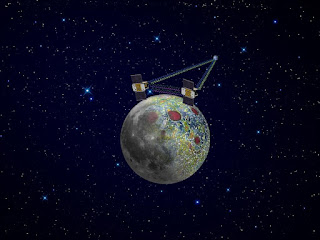 |
| Twin GRAIL Artists On Moon Orbit (NASA) |
About 24 hours away, the Gravity Recovery And Interior Laboratory (GRAIL)-A spacecraft ready to enter lunar orbit. Yesterday at 1:21 pm PST, this aircraft was within 49.500 kilometers of the moon. While the twins (GRAIL-B) prepares to enter orbit the moon early in the new year 2012 at around 2:05 pm PST.
As they close in on the moon, both orbiters move toward the moon from the south, flying nearly directly over the lunar south pole. The lunar orbit insertion burn for GRAIL-A will take approximately 40 minutes to complete and change the spacecraft's velocity by about 427 mph (687 kph). GRAIL-B's insertion burn – occurring 25 hours later -- will last about 39 minutes and is expected to change its velocity by 430 mph (692 kph).
Maneuvers is done to put them into near-polar orbit. Elliptical orbit with a period of about 11.5 hours. Slowly, over many weeks, GRAIL team will execute a series of burning to reduce the period up to 2 hours. At the start of the science phase in March 2012, the two GRAILs will be in a near-polar, near-circular orbit with an altitude of about 34 miles (55 kilometers).
During the science phase, the moon will rotate three times underneath the GRAIL orbit. The collection of gravity data over one complete rotation (27.3 days) is referred to as a Mapping Cycle. When science collection begins, the spacecraft will transmit radio signals precisely defining the distance between them as they orbit the moon in formation. Regional gravitational differences on the moon are expected to expand and contract that distance. GRAIL scientists will use these accurate measurements to define the moon's gravity field. The data will allow mission scientists to understand what goes on below the surface of our natural satellite. This information will help us learn more about how the moon, Earth and other terrestrial planets formed.
Using a precision formation-flying technique, the twin GRAIL spacecraft will map the moon's gravity field, as depicted in this artist's rendering. Radio signals traveling between the two spacecraft provide scientists the exact measurements required as well as flow of information not interrupted when the spacecraft are at the lunar farside, not seen from Earth. The result should be the most accurate gravity map of the moon ever made.
The mission also will answer longstanding questions about Earth's moon, including the size of a possible inner core, and it should provide scientists with a better understanding of how Earth and other rocky planets in the solar system formed. GRAIL is a part of NASA's Discovery Program.
Source: NASA
nice post..keep blogging
ReplyDelete